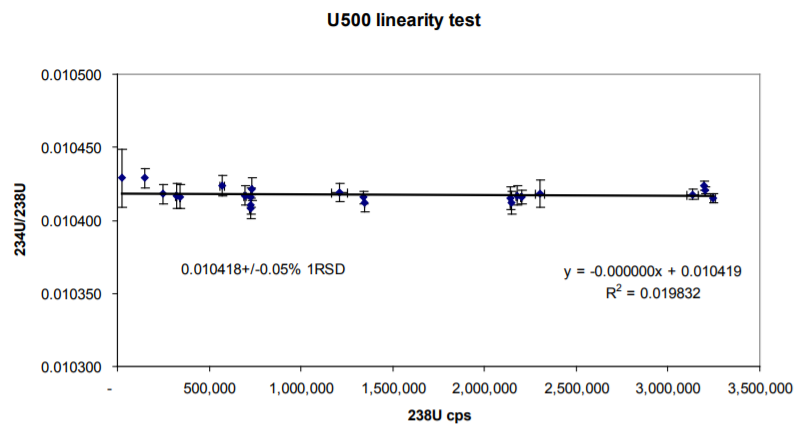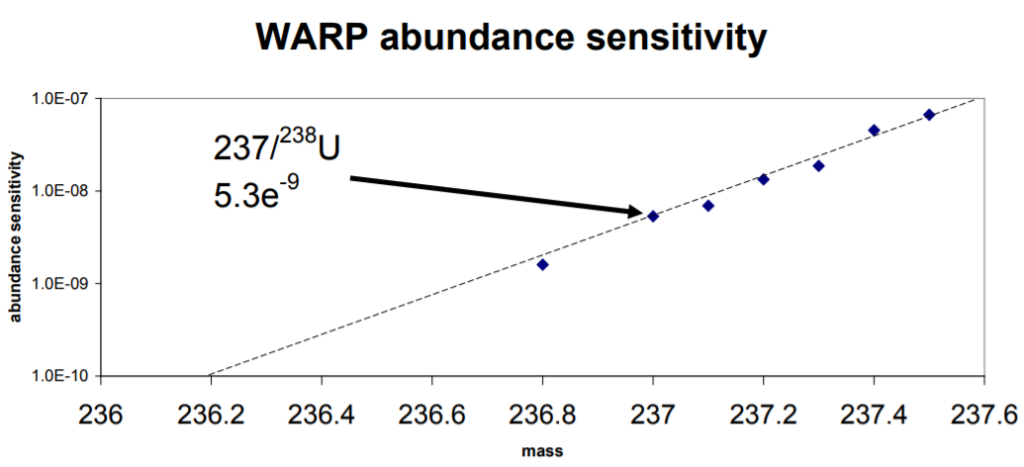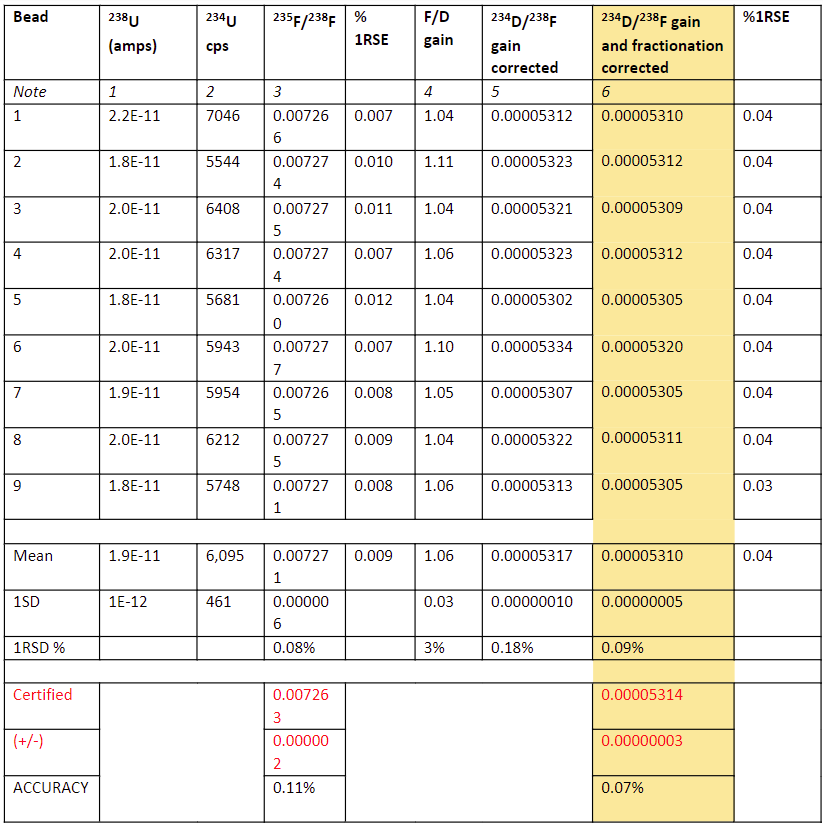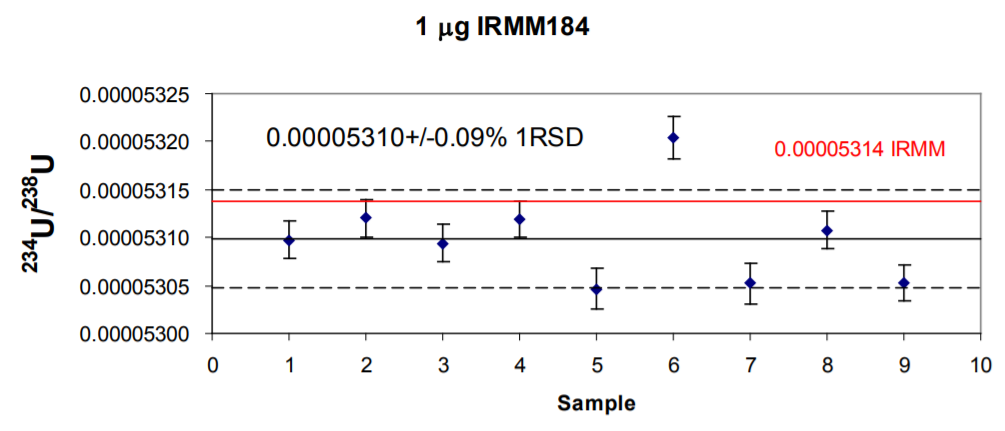Introduction
High precision measurements of 234U/238U are necessary for U-series applications in geological research. Typically, 234U is a low abundance isotope and must be determined with an ion counting detector whilst 238U is the most abundant isotope and must be determined on a Faraday collector. This note describes the performance of the Phoenix TIMS for the analysis of samples with large isotope ratios such as those in the U standard IRMM184.
High Precision and Accuracy
To obtain high precision and accuracy the relative gain between the two detectors must be measured extremely precisely for each sample. The simplest way of doing this is to analyse Uranium using a peak jumping routine where 235U is measured on both the Faraday and Daly detectors.
A two sequence approach is shown in Table 1. In the first sequence the 234U is measured on the Daly while 235U and 238U are measured simultaneously on the Faraday collectors. A peak jump to mass 235 on the Daly allows 235 Daly and 238 Faraday to be measured simultaneously. The Faraday/Daly gain can therefore be determined by dividing the 235U/238U measured in cycle 1 by that in cycle 2. This gain can then be applied for each ratio. A mass fractionation correction for the 234U/238U can be applied by using the 235U/238U measured in the first cycle.
Daly linearity
An additional element to this analysis is that the linearity of the ion counting Daly must be better than 0.1% over the range of a few thousand counts of 234U to ~1 million cps of 235U measured in the second sequence.


The linearity of the ion counting Daly was determined using the NBS U500 standard. 234U/238U was measured at different intensities of 238U, and the data normalised to 235U/238U 0.9997. Since the 235U and 238U are the same abundance, then any non linearity will have no effect on this ratio. The results are shown in Figure 1.
23 Measurements of the standard were made with a maximum count rate of 238U of 3.2e6cps 238U, and a minimum count rate of 250cps 234U. A regression line through the data produces an intercept of 0.010419 which is within error of the certified value. The standard deviation of all data is 0.05%, including the low count rate points.
All this data was obtained using a single deadtime value of 39.5ns. At count rates of 3.3e6 cps, a deadtime error of just 1ns will produce an inaccuracy in the 234U/238U of 0.3%. Since there is no evidence of a change in 234U/238U with increasing count rate, then the deadtime of the system is correct to at least 0.1ns.
Abundance sensitivity
Analyses were conducted with a source vacuum of <1e-8mbar and an analyser vacuum of 2e-9mbar. A high abundance sensitivity WARP filter was used in front of the Daly. This provides an abundance sensitivity of 5e-9 at 237 with respect to 238U, and so there is no peak tail from the 238U beneath any of the minor U isotopes (Figure 2).


Note:
- 238U measured on faraday collector
- 234U measured on ion counting Daly detector
- 235U/238U measured on Faraday collectors, used to determin mass fractionation
- 235F/238F / 235D/238F , where F is Faraday and D is Daly. This provides the Faraday/Daly gain
- 234D/238F corrected for the Faraday/Daly gain
- 234D/238F corrected for the Faraday/Daly gain and exponential fractionation corrected
IRMM184 analyses
1 microgram loads or IRMM184 were loaded onto one side filament of a triple Re filament assembly. A total of 120 ratios were measured, with each ratio comprising the cycle 1 and 2 shown in Table 1. 10 second integrations were taken for each cycle. The total length of time taken per analysis including filament warm up and focussing was 2 hours.
The results are shown in Table 2 and Figure 3.
Results and discussion
For these measurements the 235U was ~850,000cps. From the linearity data this is well below the maximum possible count rate on the Daly, but further ensures that any possible non-linearity due to poor determination of the deadtime is minimized.

The 235U/238U is slightly positively fractionated relative to the preferred value of this standard (Richter et.al 2010), however, we are using the measured value purely as a mass fractionation monitor.
The relative Faraday/Daly gain can be seen to vary by as much as 3% from filament to filament. This is probably due to the position of the sample on the filament. However, the use of the gain cancelling method eliminates this variability and this is shown in the reproducibility of the 234U/238U which is 0.18%. This is further improved by mass fractionation correction to 0.09%, which is a factor of 2 worse than the individual analysis precision.
The accuracy is within 0.07% of the certified value, though considering the size of the errors of the standard and these measurements, the data are accurate.
Summary
A multi-static analysis routine which combines Faraday and ion counting Daly detector produces sub per mil 234U/238U data by online correction of the Faraday/Daly gain. Accuracy is ensured by the linearity of the ion counting Daly.
References
Richter, R Eykens, H Kuhn, Y Aregebe, A Verbruggen, S Weyer. 2010. New average values for the n(238U)/(235U) isotope ratios of natural uranium standards. International Journal of Mass Spectrometry 295. 94-97
Download Application Note
Download the complete Application Note: Determination of 234U in IRMM184